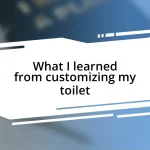Key takeaways:
- Installing a bidet can be tackled by DIY novices with basic tools and patience; proper sealing is essential to prevent leaks.
- Choosing the right bidet involves considering factors like type, size, features, and budget; personal needs play a significant role.
- Regular maintenance, including cleaning and checking water connections, ensures optimal bidet performance and longevity.
- Bidets enhance personal hygiene, reduce irritation, and promote eco-friendliness by lowering toilet paper usage.

Understanding bidet installations
When I first considered installing a bidet, I was overwhelmed by the different types available. There are standalone models, toilet attachments, and integrated options, each with its own installation requirements. I remember wondering, “Which one truly fits my needs?”
One thing I found fascinating during my research is how many people underestimate the installation process. Sure, some models can be a bit technical, but I discovered that even a novice DIYer could tackle simple attachments with just a wrench and a little patience. The moment I successfully connected mine and felt the rush of accomplishment was pretty exhilarating!
Then there’s the plumbing aspect to consider. In my case, adjusting the water supply under the sink was a small but crucial step that I was initially hesitant about. Have you ever worried about making plumbing mistakes? I did! But it all turned out to be easier than I imagined, which made all those nagging doubts fade away.

Choosing the right bidet
Choosing the right bidet can feel quite daunting given the myriad options on the market. I recall standing in the aisle of my local home improvement store, feeling a bit like a lost puppy among flashy high-tech models and simpler attachments. What really helped me was narrowing down my choices based on my bathroom space, budget, and specific needs—like whether I wanted features like warm water or heated seats.
When selecting a bidet, consider the following factors:
– Type: Standalone, toilet attachment, or integrated bidet.
– Size: Ensure it fits your existing toilet or bathroom layout.
– Features: Look for adjustable water pressure, temperature control, and self-cleaning nozzles.
– Ease of Installation: Choose models that suit your DIY skills or require minimal plumbing changes.
– Budget: Decide what you’re willing to spend and find the best option within that range.
I remember finally settling on a model that had just the right balance of features, and that feeling of satisfaction when I realized it met my needs perfectly was incomparable!

Tools required for installation
When I dove into the bidet installation process, I quickly learned that having the right tools on hand makes all the difference. To start, you’ll need basic hand tools like an adjustable wrench and a screwdriver. I remember rummaging through my toolbox and feeling a mix of excitement and anxiety, hoping I wouldn’t have to make a last-minute trip to the hardware store.
As I progressed, I realized that a Teflon tape is essential for sealing the connections. It was a little thing, but the moment I wrapped it around the threads, I felt more confident. I recall a moment of clarity when I understood that proper sealing could prevent leaks—a crucial lesson that every DIY enthusiast should embrace.
Lastly, if you’re working with the water supply, a bucket and towels will come in handy for any unexpected spills. I remember how I set up my workspace with these items nearby, creating a sense of organization that calmed my nerves. It’s these little preparations that made the installation smoother and saved me from feeling overwhelmed.
| Tool | Purpose |
|---|---|
| Adjustable Wrench | For tightening and loosening plumbing connections |
| Screwdriver | For securing components and aids in adjustments |
| Teflon Tape | To seal hose connections and prevent leaks |
| Bucket | To catch any excess water during installation |
| Towels | For drying areas and cleaning up spills |

Step by step installation guide
Once you’ve gathered your tools, the next step is to carefully read the bidet’s installation manual. I remember unfolding that packet and scanning through the instructions, feeling a bit overwhelmed initially. It’s crucial to follow the manufacturer’s guidance closely; skipping steps can lead to mistakes that are hard to fix later. Have you ever rushed through instructions only to encounter regrettable hiccups? I know I have!
Next, shut off the water supply to your toilet. I made the rookie mistake of forgetting this step on my first attempt, leading to a mini water explosion. So, take a moment to locate the valve behind the toilet and turn it clockwise. It’s such a simple action, but it’s fundamental in avoiding a chaotic mess when you disconnect the water line. Trust me, this is one area where caution pays off!
Once the water is off, remove the existing toilet seat and connect the bidet attachment according to the instructions. I found it satisfying to see how everything fit together. As I tightened the connections, I could almost feel the relief of a job well done. If you’ve ever had that moment of realizing you could tackle something you thought was intimidating, you know exactly what I’m talking about. It’s a mini victory, and frankly, I think everyone should experience it!

Common installation challenges
As I stepped into the installation phase, I encountered one common challenge: the compatibility of the bidet with my existing toilet model. It felt like a bad plot twist when I discovered that the mounting system didn’t fit quite right. Have you ever felt that sinking feeling when something doesn’t go as planned? I found myself pondering for a moment if I needed to return the bidet or improvise, which can be daunting.
Another issue I faced was dealing with water supply line connections. The old connections were rusty and stubborn, and I distinctly remember wrestling with the adjustable wrench. That little part of the process tested my patience. In hindsight, I realized that proper preparation with new connectors would have saved me a lot of trouble. I could just hear my inner voice chuckling, reminding me that sometimes, investing in quality parts pays off.
Finally, let’s not forget about the dreaded leaks. After connecting everything, I nervously turned on the water supply, half-expecting a miniature geyser in my bathroom. What I’ve learned is that even a small oversight, like not tightening a connection enough or missing Teflon tape, can lead to a damp disaster. It’s a stark reminder that patience and attention to detail are your best friends during installations. Have you ever left a project only to come back and wonder, “Did I really do that right?” Trust me, double-checking your work can save you from moments of regret.

Maintenance tips for bidets
Maintaining a bidet is simpler than it seems, but there are a few key tips to keep in mind. I’ve found that a quick weekly wipe-down with a gentle, non-abrasive cleaner prevents buildup and keeps everything looking fresh. Have you ever noticed how much easier it is to clean something that doesn’t have layers of grime on it? I certainly have!
Another aspect I prioritize is checking the water supply line for leaks. Early on, I discovered that a tiny drip could indicate a much bigger issue, and I learned to be proactive about it. Every few months, I slide under my toilet to inspect the connections, and while it might not be the most glamorous task, it’s comforting to catch potential problems before they escalate. It’s funny how those little maintenance check-ups can serve as mini peace-of-mind moments.
Lastly, I recommend flushing the bidet’s nozzle regularly to prevent mineral buildup, especially if you have hard water like I do. I remember my first experience when I noticed a drop in water pressure—turns out, neglecting this simple task led to a frustrating and unexpected cleaning session. So, why risk those pesky clogs? A quick flush every month can save you from a bigger headache later on.

Benefits of using a bidet
Using a bidet brings numerous benefits that truly enhance personal hygiene. For instance, I’ve discovered that it offers a level of cleanliness that standard toilet paper simply can’t match. Have you ever experienced that lingering feeling of not being entirely fresh? It’s a game changer! With just the gentle spray of water, I feel renewed and confident, and that’s something I didn’t expect when I first decided to install one.
Another significant perk I’ve encountered is the reduction in irritation, especially after long days. Since making the switch, I’ve noticed that my skin is happier, and I no longer dread those bathroom visits. I remember one particular experience during a colder winter—they can feel harsh on the skin! Switching to a bidet felt like introducing a warm friend that was both soothing and refreshing. Doesn’t it feel wonderful to take steps that prioritize your comfort?
Lastly, the eco-friendly aspect of using a bidet truly resonates with me. Since I’ve started using one, I’ve significantly cut down on toilet paper usage. There’s something satisfying about knowing I’m doing my part for the planet while also enhancing my daily routine. Sure, I still keep a roll handy, but it feels amazing to enjoy that fresh feeling guilt-free. Isn’t it nice to find solutions that benefit both our well-being and the environment?














